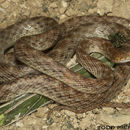en
names in breadcrumbs


Nocturnal.
Least Concern
A medium-sized, fairly slender snake. Largest Egyptian specimen has a total length of 837 mm. Tail short, tail / total length = 0.13-0.16; nostril in a partly divided nasal; loreal elongate, excluded from eye by a preocular; 9 supralabials, third, fourth, and fifth enter the eye; 240-269 ventrals, 57-66 paired sub-caudals, dorsals smooth, 21 scale rows around mid-body, anal entire (based on 4 Egyptian specimens). Dorsum pale reddish buff, usually with a series of faint large darker and lighter blotches along the mid-dorsal line, or plain; head notably reddish, with a short, dark, indistinct nuchal streak. Venter similar to dorsum, but paler and strongly iridescent.
Sinai. This taxon has been recorded from 3 localities in South Sinai: Wadi Feiran, Wadi El Sheikh, and near the St. Katherine airport. Flower (1933) also reported it from Wadi Feiran. Specimens of T. dhara from Gebel Maghara and Gebel El Giddi reported by Zinner (1974) probably also belong to this taxon.
Arabian Peninsula, Jordan, Palestine, and Sinai.
Inhabits rocky microhabitats in mountainous and hilly regions. Often in or near oases, cultivations, habitations, and rocky wadis. In the St. Katherine area it has been recorded up to an elevation of 1,200 m.
Uncommon and localized.
The Arabian cat snake (Telescopus dhara) is a species of snake of the family Colubridae.
This snake is found in Africa, Arabia and the Middle East.
The Arabian cat snake (Telescopus dhara) is a species of snake of the family Colubridae.